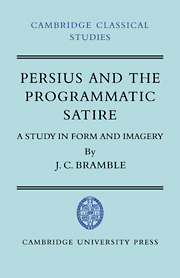Book contents
- Frontmatter
- Contents
- PARENTIBUS OPTIMIS
- Preface
- Abbreviations
- INTRODUCTION
- 1 STYLE AND EXPRESSION IN PERSIUS' FIFTH SATIRE
- 2 THE PROGRAMMATIC SATIRE AND THE METHOD OF PERSIUS I
- 3 THE NATURE AND SOURCES OF PERSIUS' IMAGERY
- 4 PERSIUS' FIRST SATIRE: ANALYSIS
- 5 GRANDEUR AND HUMILITY: JUVENAL AND THE HIGH STYLE
- APPENDIX 1 Accius and Pacuvius at Persius I. 76–8
- APPENDIX 2 Virgil and the moderns at Persius I. 96
- APPENDIX 3 The image of the child in ancient satire and diatribe
- APPENDIX 4 The disclaimer of malice
- TEXT
- TRANSLATION
- 1 INDEX OF MODERN AUTHORS
- 2 INDEX LOCORUM POTIORUM
- 3 INDEX OF IMAGES, TOPICS AND WORDS
1 - STYLE AND EXPRESSION IN PERSIUS' FIFTH SATIRE
from PARENTIBUS OPTIMIS
Published online by Cambridge University Press: 05 June 2014
- Frontmatter
- Contents
- PARENTIBUS OPTIMIS
- Preface
- Abbreviations
- INTRODUCTION
- 1 STYLE AND EXPRESSION IN PERSIUS' FIFTH SATIRE
- 2 THE PROGRAMMATIC SATIRE AND THE METHOD OF PERSIUS I
- 3 THE NATURE AND SOURCES OF PERSIUS' IMAGERY
- 4 PERSIUS' FIRST SATIRE: ANALYSIS
- 5 GRANDEUR AND HUMILITY: JUVENAL AND THE HIGH STYLE
- APPENDIX 1 Accius and Pacuvius at Persius I. 76–8
- APPENDIX 2 Virgil and the moderns at Persius I. 96
- APPENDIX 3 The image of the child in ancient satire and diatribe
- APPENDIX 4 The disclaimer of malice
- TEXT
- TRANSLATION
- 1 INDEX OF MODERN AUTHORS
- 2 INDEX LOCORUM POTIORUM
- 3 INDEX OF IMAGES, TOPICS AND WORDS
Summary
Persius was not a wanton obscurantist. He wrote as he did for a reason; discontented with the state of literature, he required something other than the traditional poetic idiom for the expression of his ideas. Conventional literary language had, in his opinion, become too bland and voluble to have any true reserve of meaning. From the first satire we see that he regarded contemporary literature as utterly decadent and meaningless. This work will occupy my attention for most of this study, but for the moment I should like to consider two passages which occur towards the beginning of the fifth satire. One of these is openly programmatic, the other only obliquely so, but both are more informative guides to Persius' stylistic aims than anything in the predominantly negative first satire. Here we are allowed insight into the reasons for his adoption of a difficult and complex manner as an antidote to triviality. The first passage, V. 14–16, is commonly adduced with reference to Persius' methods. After a scornful repudiation of the high style, represented here by the hundred voices of the inspired bard, he advises himself, through the medium of an interlocutor, of the procedure to be adopted:
‘verba togae sequeris iunctura callidus acri, ore teres modico, pallentis radere mores doctus et ingenuo culpam defigere ludo.’
- Type
- Chapter
- Information
- Persius and the Programmatic SatireA Study in Form and Imagery, pp. 2 - 15Publisher: Cambridge University PressPrint publication year: 1974

